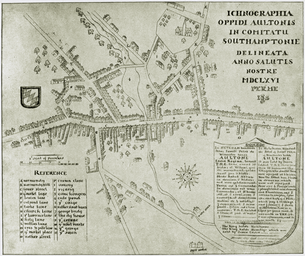| Battle of Alton | |||||||
|---|---|---|---|---|---|---|---|
| Part of First English Civil War | |||||||
| |||||||
| Belligerents | |||||||
|
|
| ||||||
| Commanders and leaders | |||||||
|
Sir Ralph Hopton Colonel Richard Boles | Sir William Waller | ||||||
| Strength | |||||||
|
~1,000: 300–500 horse[1] 600+ infantry[2] |
5,000:[3] Westminster Trained Bands (the Red Regiment) Green Auxiliary Trained Bands of London Tower Hamlets Auxiliary Trained Bands (the Yellow Regiment) A foot regiment (Waller's own) Horse that had survived Roundway Down[4] | ||||||
| Casualties and losses | |||||||
|
100+ 500+ captured[5] | ~10[5] | ||||||

The Battle of Alton (also Storm of Alton),[7] of the First English Civil War, took place on 13 December 1643 in the town of Alton, Hampshire, England.[α] There, Parliamentary forces serving under Sir William Waller led a successful surprise attack on a winter garrison of Royalist infantry and cavalry serving under the Earl of Crawford.[3] The Battle of Alton was the first decisive defeat of Sir Ralph Hopton, leader of Royalist forces in the south, and the event had a significant psychological effect on him as commander.[7] More important to Hopton was the loss of men, however, as he was already short-handed in much-needed infantry. The successful Parliamentarians were able, after their victory, to attack and successfully besiege Arundel, a larger and more formidable Royalist outpost to the south-east of Alton.[2][5]
At dawn on the 13th, as Waller's army approached Alton, Crawford fled with the cavalry to Winchester, leaving Colonel Richardus Boles to defend Alton with only the infantry.[β] Outnumbered and overpowered, Boles's men were soon forced to seek refuge in the Church of St Lawrence, where they made a desperate last stand. Boles was killed, along with most of his remaining men. The Parliamentarians won a clear victory, losing only a few men and taking many prisoners.[8]
Boles's fight is also notable for its demonstrated drama and heroism.[2] Stories boast that Boles killed a number of his enemies before falling himself. The battle of Alton is known as one of the "most savage encounters" of the English Civil War.[5] Musket holes from the fight can still be seen in the south door to the church and inside, where so many cornered men were killed and captured.[9] The Battle of Alton was also the first battle in the English Civil War to use leather guns, employed effectively by Waller before and during the battle proper.[10]
- ^ Curtis (1896), p. 42.
- ^ a b c Wedgwood (1959), p. 281.
- ^ a b Curtis (1896), p. 43.
- ^ Kenyon (1988), pp. 85–87.
- ^ a b c d Kenyon (1988), p. 85.
- ^ Curtis (1896), p. 2.
- ^ a b Young & Holmes (1974), pp. 161–163.
- ^ Curtis (1896), p. 48.
- ^ MacLachlan (1999), p. 182.
- ^ Adair (1997), p. 143.
© MMXXIII Rich X Search. We shall prevail. All rights reserved. Rich X Search

